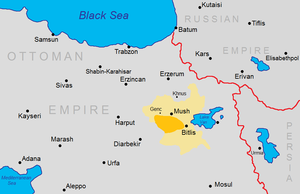1894 Sasun rebellion
| First Sasun Resistance | |||||||
|---|---|---|---|---|---|---|---|
 Location of the 1894 and 1904 Sasun uprisings | |||||||
| |||||||
| Belligerents | |||||||
| Social Democrat Hunchakian Party | |||||||
| Commanders and leaders | |||||||
|
Mihran Damadian Hampartsoum Boyadjian Hrayr Dzhoghk | |||||||
| Strength | |||||||
| 8,000[1] | 10,000[1] | ||||||
| Casualties and losses | |||||||
| 20,000 rebel and civilians[1] | 550[1] | ||||||
The Sasun rebellion of 1894, also known as the First Sassoun resistance (Armenian: Սասնո առաջին ապստամբութիւն), was the conflict between Ottoman Empire's Hamidiye forces and the Armenian fedayi belonging to the Armenian national movement's Hunchakian party in the Sassoun region.
Background[]
The Social Democrat Hunchakian Party was an Armenian national movement active in the region. In 1894, Sultan Abdul Hamid II began to target the Armenian people in a precursor of the Hamidian massacres. This persecution strengthened devolution sentiment among Armenians.[2][3]
In Sason Armenians were organized by Hunchak activists, such as Mihran Damadian, Hampartsoum Boyadjian and Hrayr Dzhoghk.
Conflict[]

Sassoun was the location for the first notable battle in the Armenian resistance movement. The Armenians of Sassoun confronted the Ottoman army and Kurdish irregulars at Sassoun, succumbing to superior numbers.[4]
Foreign news agents protested vehemently against the Sassoun event; British Prime Minister William Ewart Gladstone called Hamid "the Great Criminal" or "the Red Sultan". The rest of the Great Powers also protested and demanded the execution of Ottoman Sultan Hamid's promised reforms. An investigation committee composed of French, British, and Russian representatives were sent to the region in order to examine the event.[4]
Aftermath[]
In May 1895, the aforementioned foreign powers prepared a set of reforms. However, they were never carried out, because they were not actively imposed on Ottoman Turkey. The Russian Empire's policies vis-a-vis the Armenian question had changed. In fact, the Russian foreign minister Alexei Lobanov-Rostovsky supported Ottoman integrity. Moreover, he was so anti-Armenian that he wanted an "Armenia without Armenians". On the other hand, Britain had gained considerable influence and power in former Ottoman Egypt and Cyprus, and for Gladstone, good relations with the Ottomans were less important than before. Meanwhile, Turkey had found a new European ally, Germany's Bismarck. The Ottoman Empire thus felt free to commit further massacres, in 1896.[4]
See also[]
Footnotes[]
- ^ a b c d A Crime of Silence: The Armenian Genocide , p 133
- ^ "The Rise of Nationalism and the Collapse of the Ottoman Empire". Archived from the original on 2020-10-30.
- ^ Ter Minassian, Anahide (2012). Nationalism and Socialism in the Armenian Revolutionary Movement (1887-1912). İletişim Yayınları.
- ^ a b c Kurdoghlian, Mihran (1996). Hayots Badmoutioun, Volume III (in Armenian). Athens, Greece: Hradaragoutioun Azkayin Ousoumnagan Khorhourti. pp. 42–44.
- 1894 in the Ottoman Empire
- Armenian national liberation movement
- 19th century in Armenia
- History of Batman Province
- Bitlis vilayet
- Armenian rebellions in the Ottoman Empire
- Rebellions against the Ottoman Empire
- 19th-century rebellions